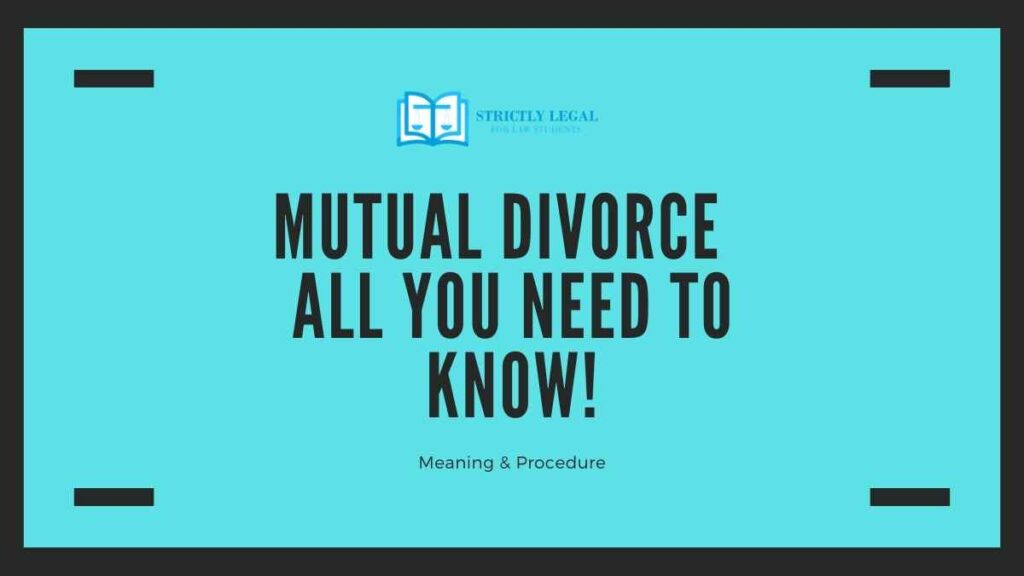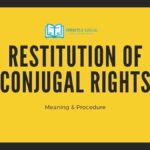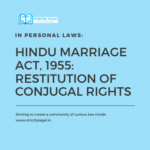Divorce is never the only solution to solve dissimilitudes, disagreements, or any sort of family issues but for some people, it becomes the need of the hour. The word “ Mutual Divorce” means Dissolution of one’s marriage with the other, when both the spouses mutually (together) agrees to terminate their marriage.
Divorce is a legal process where the union of the two individuals comes to an end, which might be formalized under different personal laws I.,e Hindus, Sikhs, and Jains are governed under Hindu Marriage Act, 1955; Christians are governed under Indian Divorce Act, 1869 and Indian Christian Marriage, 1872; The Muslims are governed by Personnel laws of Divorce and also the Dissolution of Marriage Act,1939 and the Muslim Women (Protection of Rights on Divorce) Act,1986.
Also Read: How To Send A Legal Notice For Divorce?
Table of Contents
COMMON LEGAL GROUNDS FOR DIVORCE
- Adultery
- Desertion
- Insanity
- Renunciation
- Cruelty
- Presumption of Death
- Venereal disease
DIFFERENT STATUTES ON MUTUAL CONSENT DIVORCE
- The “Hindu Marriage Act, 1955” inserted Section 13B bringing into light the “divorce” with mutual consent of the spouses, providing for a total of 18 months of decree for divorce that can be passed.
- Likewise, Indian Christians can dissolute or terminate the terms of their marriage by taking the help of “The Indian Divorce Act, 1869”. By Section X A both the parties may file a mutual divorce petition.
- In terms of the “Special Marriage Act, 1954” a divorce petition can be filed by both or either of the parties under 10A of the Act.
JUDGMENTS ON MUTUAL CONSENT DIVORCE
In Mandeep Kaur Bajwa v. Chetanjeet Singh Randhawa [AIR 2015, Punjab and Haryana 160], the parties to the court could not adjust with each other’s company immediately after their marriage for lack of compatibility and disagreements. They lived together as legally wedded husband and wife for about three months from their marriage, thereafter the appellant I.e., the Wife flew to Canada, making it impossible for her to come back India time and again. The parties filed a petition under section 13(B) of Hindu Marriage Act, 1955 after a year of marriage where both the parties’ first notion were recorded. The second motion of statements were recorded after another year under Section 13 (2) of the Act. Therefore, the parties were accorded for a decree of divorce under Section 13 of the Hindu Marriage Act, 1955.
In Shaikh Taslim Shaikh Hakim v. The State of Maharashtra and another [2022 LiveLaw Bom 121], the petitioner (husband) and the respondent no.2 (wife) mutually got separated and addressed the Family Court, Parbhani for commencement of their marital status with regards to Section 2 of Muslim Personal Law (Shariat) Application Act, 1937 read with Section 7(1)(b) of the Family Courts Act, 1984, where the Ld. Judge of the Family Court fairly put in the provisions of the Muslim Personal Law (Shariat) Application Act, 1937 to the parties before the court and accordingly commenced the status of their marriage as “no more in existence” by mutual consent.
In Saumya Ann Thomas v. Union of India, 25 February 2010, it was held that the time period of Section 10A of the Indian Divorce Act,1869 I.e., “the spouses have to be living separately for two years or more” is itself constitutionally violating the fundamental rights of an individual as a period of “two years” is violating Article 14 and Article 21. To safeguard the provision and keep away from the vice of the unconstitutionality, the period of ‘two years” in the Act is read down to a period of “one year” of stipulation in the Indian Divorce Act, 1869 and that the petitioners of the case are enfranchised to accord the decree of divorce.
Also Read: Restitution of Conjugal Rights | Meaning & Procedure
DOCUMENTS REQUIRED TO FILE A DIVORCE PETITION
- Marriage Proof of the parties
- Residential Proof of the husband and the wife
- Four Photographs of marriage
- Income Tax Statement for the past three years
- Particulars on income and possession
- Particulars on property and asset owner
- Information about each other’s family
- Proof of staying separately for one year before filing the petition
- Proof with regards to failed attempts for reconciliation
STEPS INVOLVED IN FILING A PETITION FOR MUTUAL CONSENT DIVORCE
- Before initiating a joint petition you must serve a Legal Notice for Divorce seeking mutual consent.
- The first motion of filing a petition for mutual divorce includes filing a petition jointly before the court.
- The parties to the divorce have to appear before the court to record statements after filing the petition.
- The Court will then examine the statements, documents, and reconciliation and then passes an order on First Motion.
- The Court then assigns a “Cooling Off” of six months to the parties to reconsider their decision before legally proceeding further.
- The filing of the second motion is done within a period of eighteen months of the first motion.
- A decree of divorce is passed by the court.
Frequently Asked Questions on Mutual Consent Divorce
A mutual divorce petition can be filed where the spouses where last residing as husband and wife or where the husband and the wife are presently residing I.e., District Court or Family Court.
The time provided by the court after filing the petition by the husband and the wife to trump up their minds and to decide if they still want to go forward with the divorce proceedings. This act is deliberately done by the Honorable Court to safeguard the sanctity of marriage and to prevent the separation of the union which might have taken place due to the heat of an argument.
In India, the first motion under proceedings of mutual divorce is the filing of a petition in the Court where both the parties I.e., the husband and wife mutually agree to terminate their marriage. The second motion under proceedings of mutual divorce is when both the parties affirm they want to proceed with the divorce proceedings after the cooling-off period.
The only good thing about this kind of divorce is the child is not involved in fights or proceedings as to the right of custody, rather the point of the right of custody of the child is mutually taken up by the husband and the wife, as both of the parties are taken to be able enough.
Alimony and Maintenance are decided upon the consent of both the parties to divorce, however, separate proceedings/ litigation can always be pursued irrespective of whether the divorce is obtained mutually or not. The amount is decided taking into account the social status, maintenance of the wife, maintenance of the education expenses of the child, wife’s income (if any), the ability of the wife to maintain herself, etc

Law student.
Believes in penning down thoughts!




